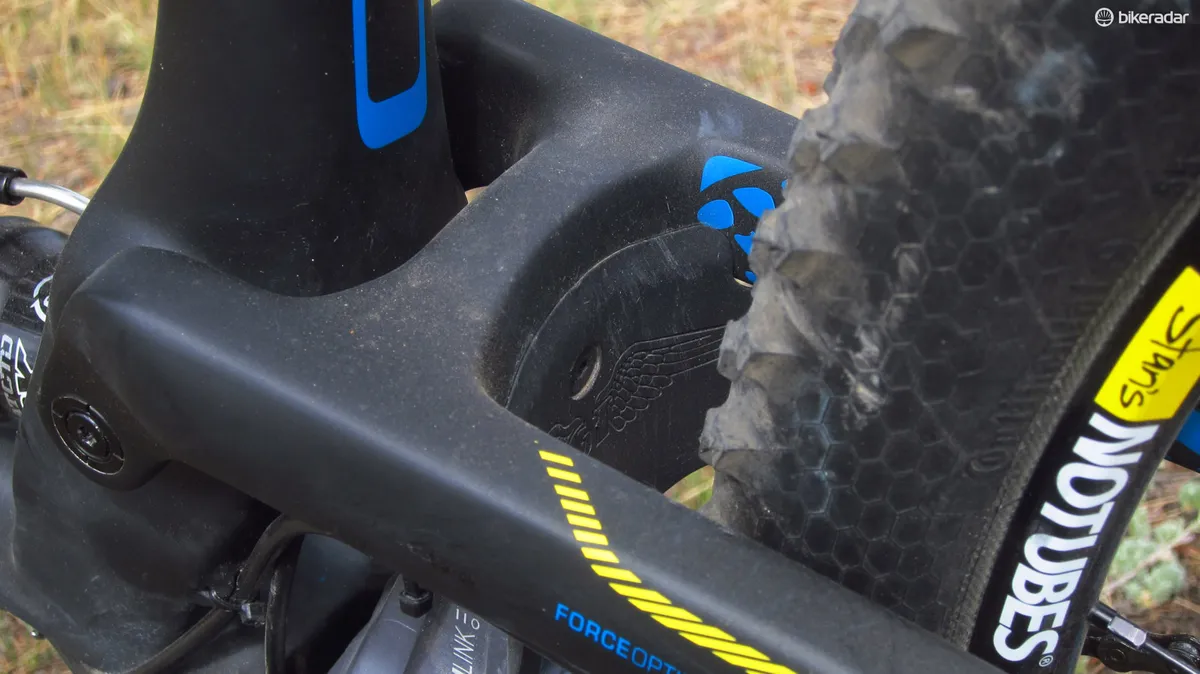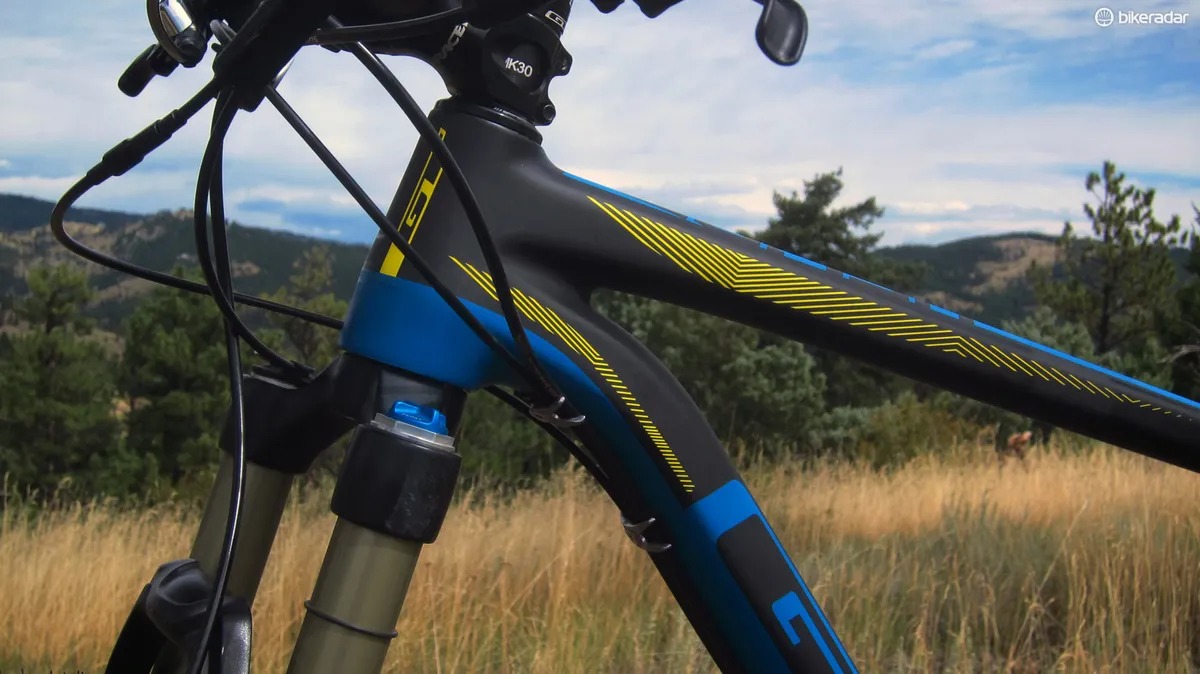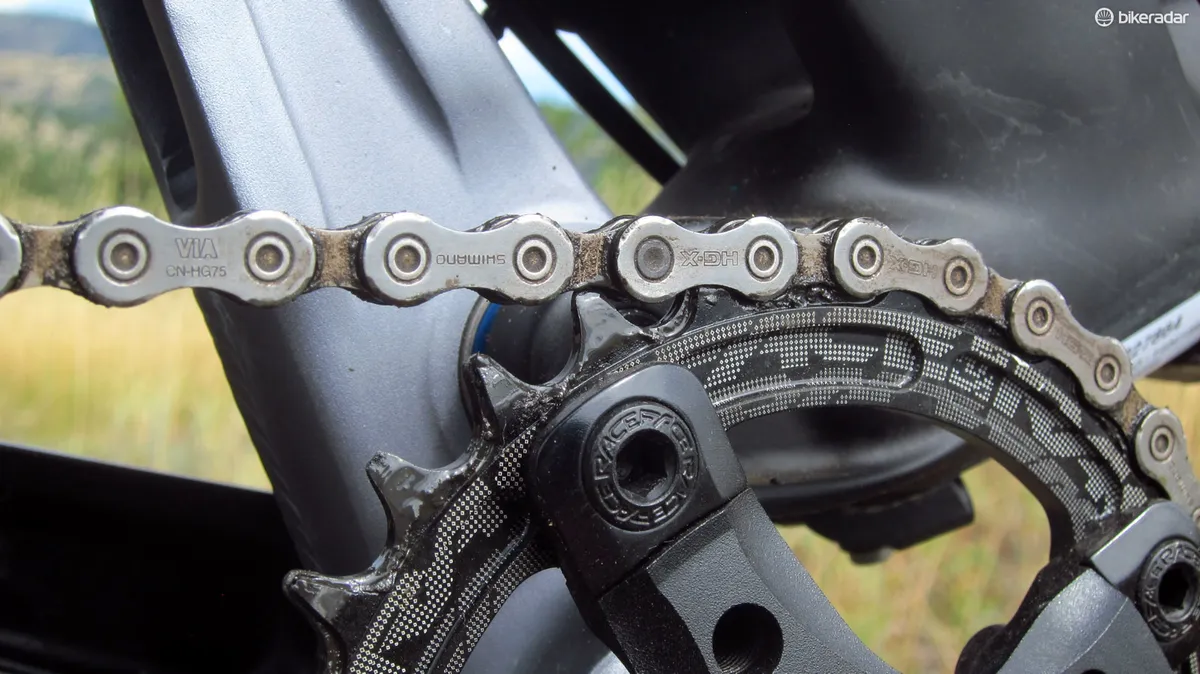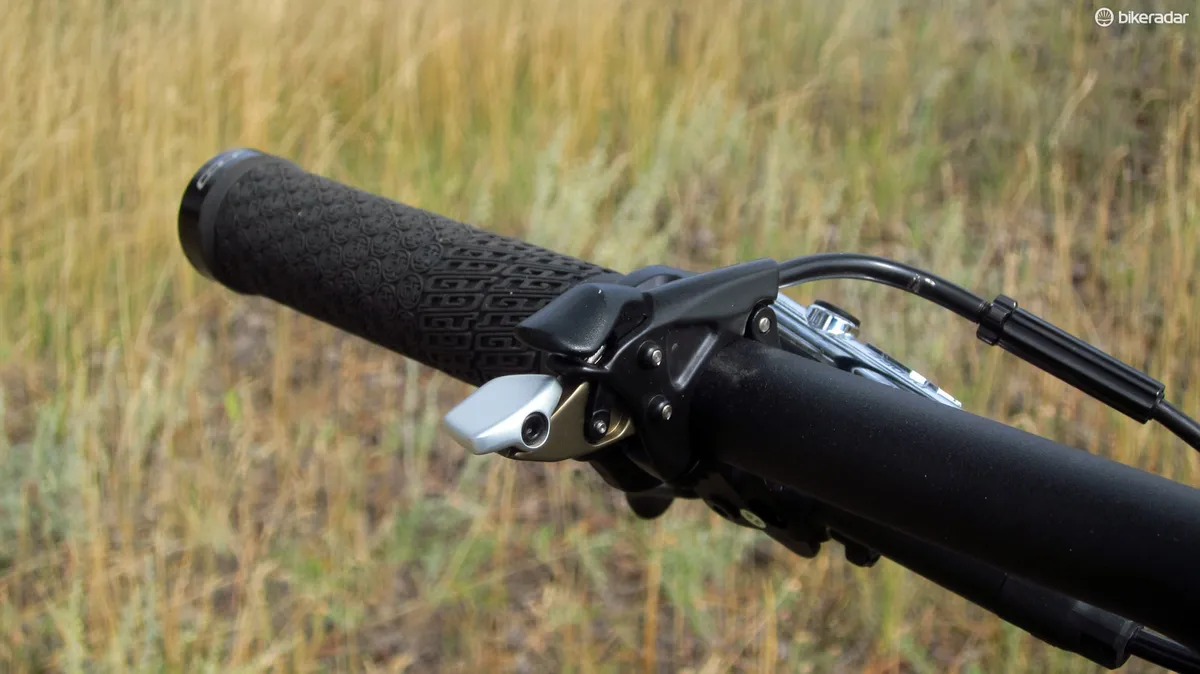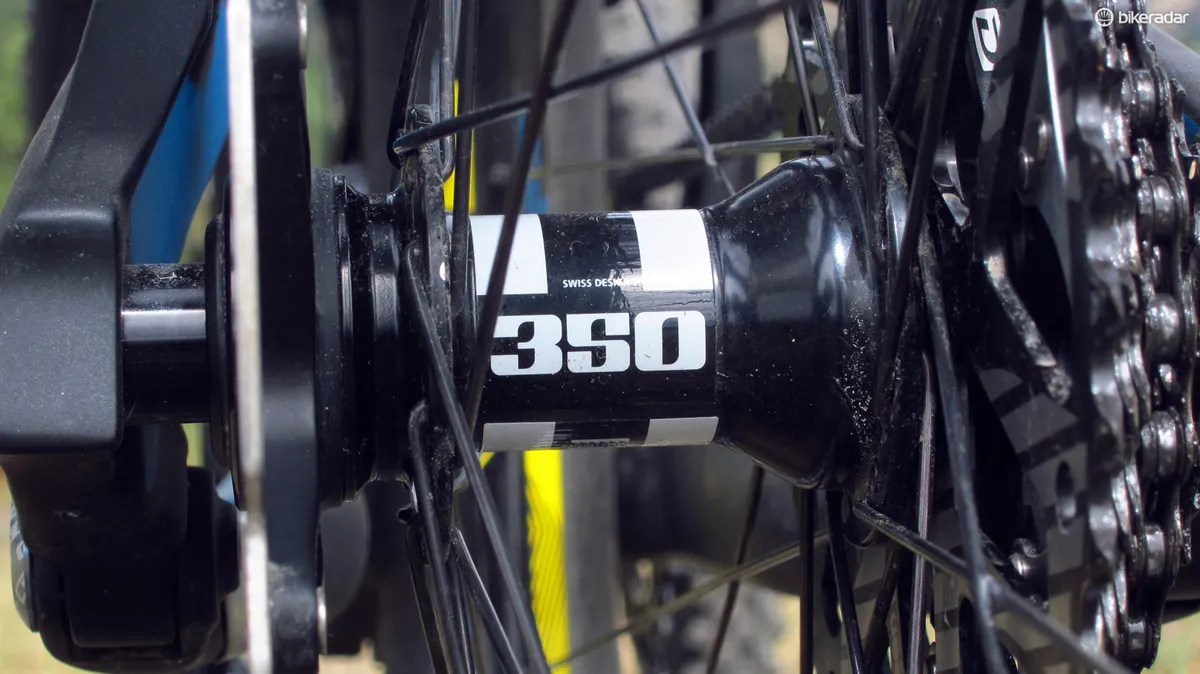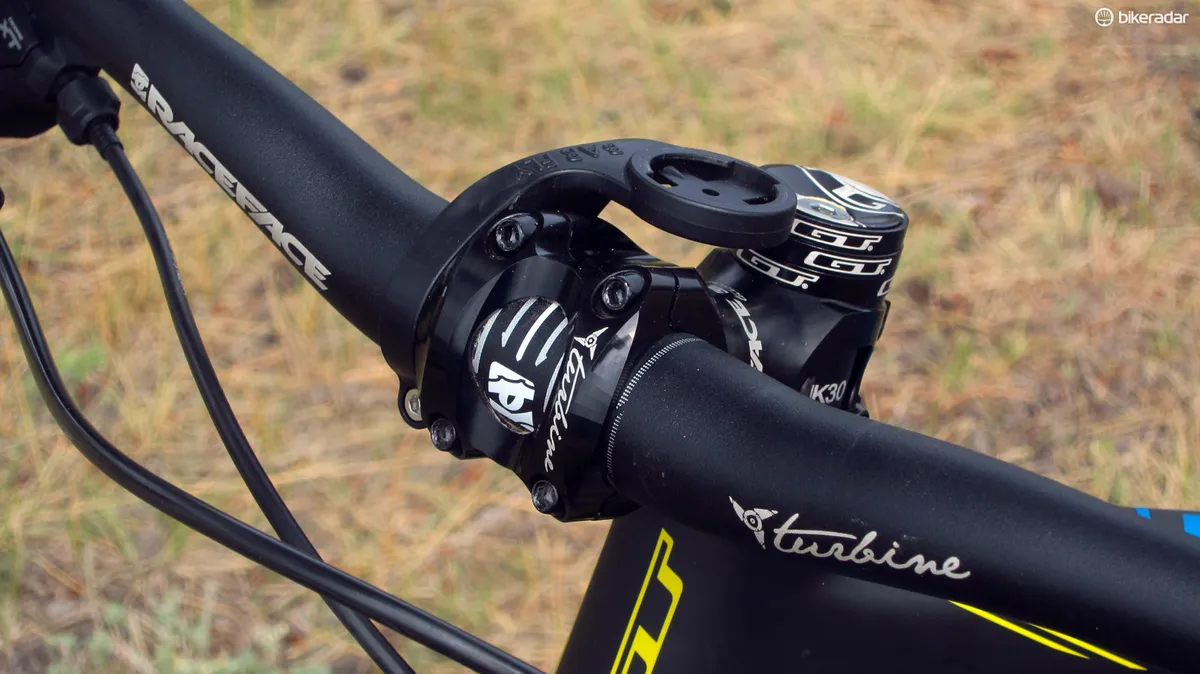The new GT Helion Carbon Pro is one of the latest 'new-school' cross-country bikes with modest amounts of travel, medium-sized 27.5in wheels, and a long geometry that emphasize rider entertainment value above all else.
Who says enduro bikes get to have all the fun? This thing is an absolute riot.
- Highs: Fantastic suspension design, great handling, super fun
- Lows: Clunky shifting, clunky suspension remote, slow-engaging rear hub
- Buy if: You like a big dose of fun with your XC
Ride and handling: Playful personality, brilliant rear suspension design
The Helion Carbon Pro may not make a huge impact numbers-wise, with its modest 110mm travel and fairly typical 69.5-degree head tube, but on the trail you could easily be convinced you're riding a longer-legged trail machine.
The very low bottom bracket and long front triangle combine with the relatively short stem and wider bar for lots of high-speed stability, excellent cornering manners and a generally frisky feel that goads you into taking a rougher line or airing it out just that little bit more.

The new AOS rear end is one of the keys to the Helion Carbon Pro's super fun personality
The new Angle Optimized Suspension design makes exceptionally good use of that limited movement. Where some bikes can get hung up on bigger bumps – especially at slower speeds and with smaller wheels – the Helion Pro steamrolls over them with a slightly rearward axle path that devours square-edged impacts.
Drive traction is fantastic as a result, especially on uneven terrain. Just keep applying the power – while seated or standing, at high speeds or low – and the rear end faithfully digs in over every bump to maintain contact with the ground while maintaining forward momentum. One of our most frequent test rides was at Hall Ranch, just north of Boulder, Colorado, and the Helion Carbon Pro made quick work of that trail's notoriously tricky rock garden ascent.
The AOS design cancels out the usual drawbacks of an up-and-back axle path: namely, the excessive pedal feedback that come with the constantly changing chainstay length. Instead, the clever Path Link linkage moves the crankset back and forth as the rear wheel moves through its travel to keep that dimension relatively constant.
We never noticed that slight movement while riding but we sure did notice the way power was efficiently transferred to the ground – nor did we feel any harsh kickback through the pedals when slamming into bumps at speed.

The Path Link allows GT to include the bump-eating benefits of a high single-pivot axle path but without the usual pedaling feedback
Keep in mind that just because the Helion Carbon Pro is a bit of a hooligan, that doesn't mean it can't be a serious cross-country machine as well. It's generally snappy and responsive when you put your foot on the gas, the carbon chassis is impressively stiff (especially out back), and the suitably stubby head tube allows for an aggressively low grip height should you want it.
Add all of the above with the bike's reasonable weight and it's a solid formula for a cracking good time on the trail. The Helion Carbon Pro may not the absolute best in any particular performance attribute but taken in total, it's far more capable than a cursory glance on paper might otherwise suggest.
Frame: Lightweight carbon construction, (mostly) excellent attention to detail
GT doesn't try to make the Helion Carbon Pro the lightest frame around. Its actual weight is 2,517g (5.55lb, with shock, cable hardware, rear derailleur hanger, and seatpost collar), making it highly competitive but not class-leading.
It's clear that there was a lot of attention paid to stiffness, however, which has much to do with the bike's fun and confident feel on the trail. In particular, the seatstays are positively massive with no additional joints in between the very wide-stance main pivot and the rear wheel. Moreover, that main pivot area is noticeably burly.

There's a lot of meat in this area and it yields real dividends in terms of stiffness on the trail
Instead of going the easier route of pressing bearings into the swingarm ends and then connecting everything with two half-shafts, GT instead anchors the cartridges in the stouter seat tube, and then passes a one-piece thru-axle through the whole assembly with locking collet-type hardware at the ends to keep unwanted twist at bay. It's a signature construction method of designer Peter Denk (whom GT's parent company stole away from Scott) and one that we've found to be quite effective in the past.
Down below, the Path Link uses a hollow clamshell design made from two forged-and-machined aluminum halves that are welded together to form a lightweight and stiff box-section. As an added bonus, the aluminum construction naturally lends itself to threading for a secure (and creak-free) bottom bracket installation.

Threads – yay!
All of the suspension hardware is situated far down on the chassis. While it's debatable if the low center of gravity is actually noticeable while riding, it does open up the front triangle and create plenty of room for a conventionally mounted water bottle cage.
Other nice details include dual cartridge bearings at each dropout pivot, lowered chainstays to minimize chain slap, and a mini-fender to protect the otherwise-exposed rear shock from debris coming off of the tire.

A small mini-fender protects the rear shock from anything flying off of the rear tire
Unfortunately, not all of the frame's details are so well thought-out. In particular, a few aspects of the cable routing are downright awful.
All of the lines are externally routed along the bottom of the down tube and while some might lament the exposed position, the accessible location and the tidy-looking aluminum clamps make for easier maintenance when needed.
But to maintain a clean external appearance, the rear derailleur takes an unforgivably circuitous path with not one, not two, but three tight right-angle bends. Making matters worse is a section of exposed inner wire underneath the frame and a wholly unnecessary internal jog through the swingarm that's just 200mm long with entry and exit ports that don't point directly toward each other.
And if you don't torque those clamps down just right (and remember to use threadlocking compound to keep them from falling out), it's all too easy to squash the lines and pinch the cable inside. All of that creates a perfect recipe for friction that yields so-so shift performance and requires an overly firm push on the shifter paddles.

The external cable routing is a nice idea but some of the details aren't well thought-out
Thankfully, though, it's a setup that can be corrected relatively easily by essentially mirroring the routing of the rear brake on the other side of the frame – and we hope GT does that for next year.
Equipment: A few mis-steps mar the otherwise solid package
Just as the poor rear derailleur cable routing mar what would otherwise be a very well thought-out frame, a few misfires muddy what would otherwise be a very solid build kit.
GT's product managers have made mostly excellent choices all around. The spec includes a Shimano Deore XT shifter, rear derailleur, cassette, and hydraulic disc brakes with meaty 180mm rotors; a Race Face Turbine crankset, forged-and-machined alloy stem, low-rise handlebar, and two-bolt seatpost; medium-wide NoTubes Crest tubeless-compatible rims laced to reliable (but slow-engaging) DT Swiss 350 hubs; and Continental X-King tires in a usefully wide 2.2in size.

The Stan's NoTubes ZTR Crest rims and Continental X-King 2.2 tires match up well
Actual weight for our medium-sized tester is a highly respectable 11.67kg (25.73lb), without pedals.
Brake performance is outstanding, the tires are pleasantly fast and grippy provided the ground isn't too loose, the cockpit is well shaped, and the grips are comfortable despite being rather hard. About the only thing missing is a dropper seatpost (GT has at least included routing for both externally and internally actuated models).
Single-ring drivetrains are the hot new thing at the moment but as GT has decided to stick with Shimano – whose current 1x offerings can't match the 420 percent range of SRAM's XX1, X01, or X1 groups – its product managers have instead turned to e*thirteen's 42-tooth EX add-on cog as standard equipment.
This substantially boosts the range of the standard 11-36T Deore XT cassette and works well with the stock Race Face Narrow/Wide chainring to provide a usefully versatile and secure 1x setup.

The Race Face Narrow/Wide chainring is fantastic…
However, the 42T cog exceeds the rear derailleur's stated 36T maximum capacity and shift performance on some of the bigger gears suffers as a result, with the derailleur's cable arm even occasionally hanging up on the chain itself.
At the opposite end, the absent 15T cog (it has to be removed to make room for the 42T EX) not only makes for an awkwardly big ratio gap between the remaining 13T and 17T gears but a slow and noisy shift between those two as well. That needlessly convoluted path for the rear derailleur housing mentioned above only makes matters worse.
Interestingly, GT doesn't install the EX cog at the factory; instead, it's included in a separate box for installation by the dealer. Riders who need the extra range will likely still be better served with it bolted in place but shift performance will unquestionably be better with the stock Deore XT cassette left intact.

…the e*thirteen EX cog, not so much
GT has also decided to include a remote suspension lockout lever that simultaneously operates both the rear shock and fork. The need for such a thing is debatable to begin with, given how efficiently the rear end pedals in the fully open position, but more importantly, the remote doesn't work very well.
Coupling the spring tension of both the fork and rear shock damper switches makes for a frustratingly stiff push on the lever, plus there's an awful lot of housing to pull the cable through, which creates a lot of friction. To add insult to injury, the lever ergonomics aren't very good.
Unfortunately, all of these missteps stand out more because of what GT has gotten so right elsewhere. After all, buzzkills are all the more annoying when the party is otherwise really, really fun.

Editor's note: This particular model isn't currently available in the UK. The Helion Carbon Expert uses the same frame with a different build kit.
For more information head to www.gtbicycles.com.
Complete bike specifications (as tested)
- Frame: GT Helion Carbon, 110mm-travel
- Rear shock: Fox Racing Shox Float CTD Remote BoostValve
- Fork: Fox Racing Shox 32 Float 27.5 CTD Remote FIT, 110mm travel
- Headset: FSA Orbit C-40-ACB, 1 1/8 to 1 1/2in tapered
- Stem: Race Face Turbine
- Handlebar: Race Face Turbine 3/4in Riser
- Grips: GT Statement lock-on
- Front brake: Shimano Deore XT BR-M785 w/ 180mm SM-RT81 Center Lock rotor, metallic pads
- Rear brake: Shimano Deore XT BR-M785 w/ 180mm SM-RT81 Center Lock rotor, metallic pads
- Brake levers: Shimano Deore XT BL-M785
- Rear derailleur: Shimano Deore XT Shadow Plus Direct Mount RD-M786-D (GS)
- Shift lever: Shimano Deore XT SL-M780, right only
- Cassette: Shimano Deore XT CS-M771-10 w/ e*thirteen 42T EX cog
- Chain: Shimano SLX HG-75
- Crankset: Race Face Turbine w/ 32T Race Face Narrow/Wide chainring
- Bottom bracket: Race Face Turbine X-Type
- Pedals: n/a
- Rims: Stan's NoTubes ZTR Crest 27.5, 32h
- Front hub: DT Swiss 350 Center Lock, 15x100mm thru-axle
- Rear hub: DT Swiss 350 Center Lock, 12x142mm thru-axle
- Front tire: Continental X-King, 27.5 x 2.2in
- Rear tire: Continental X-King, 27.5 x 2.2in
- Saddle: fi'zi:k Tundra 2 w/ manganese rails
- Seatpost: Race Face Turbine




